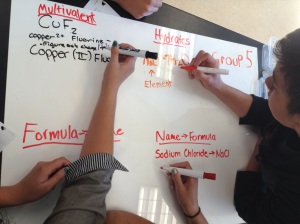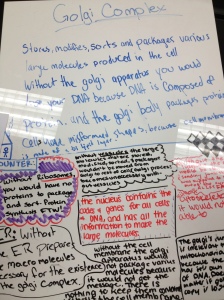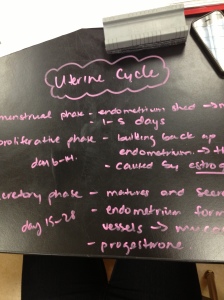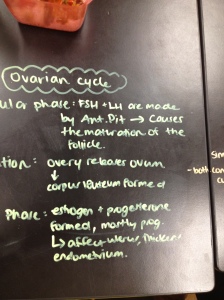Whiteboards…a must have
Last year I stopped by to watch Carolyn Durley’s (@okmbio) flipped class in action and I got more than I bargained for. Of course, I saw how wonderful her flipped class was but I also saw students using whiteboards in the classroom. Luckily, my VP, Myron Dueck (@myrondueck) was with me and saw how useful they were so he found some money to buy me a class set.
I originally figured that the whiteboards would increase engagement due to the novelty factor and they would also save paper when students do practice problems on the boards instead of the paper but I never realized how powerful they would be.
Student Collaboration
When students are in their group discussions, based on the flipped video content, they use them to compile their thoughts and work through problems and concepts. The white boards are 3ft x 2ft so it allows for multiple students to use them at the same time. The large size also allows for students to see what other students are writing down.
Formative assessment tool
 This is the greatest impact of the whiteboards in my opinion. I have stolen and also created a number of games/ activities that allow both students and myself to check in and see their current understanding of the concepts. Whiteboarding (yes, it is now a verb) creates a snap shot of student understanding so I can see where the students are at in terms of their understanding, and consequently, where we need to go next. The picture below shows the biology 12 “silent debate”. The learning outcome was to understand the function of each “organelle” in a cell. In groups of 2/3, students choose one organelle and argue, concisely, on the whiteboard why their organelle is the MOST important in the cell. Students rotate to the next whiteboard and argue why their organelle is more important than the organelle on the white board. They write their argument down. They continue to go from one whiteboard to the next until they have argued each case. The students finish at their original board where they can see the other arguments.
This is the greatest impact of the whiteboards in my opinion. I have stolen and also created a number of games/ activities that allow both students and myself to check in and see their current understanding of the concepts. Whiteboarding (yes, it is now a verb) creates a snap shot of student understanding so I can see where the students are at in terms of their understanding, and consequently, where we need to go next. The picture below shows the biology 12 “silent debate”. The learning outcome was to understand the function of each “organelle” in a cell. In groups of 2/3, students choose one organelle and argue, concisely, on the whiteboard why their organelle is the MOST important in the cell. Students rotate to the next whiteboard and argue why their organelle is more important than the organelle on the white board. They write their argument down. They continue to go from one whiteboard to the next until they have argued each case. The students finish at their original board where they can see the other arguments.
No white Boards?
If there aren’t any whiteboards available, you can always improvise. To mix things up, I started “Fluorescent Fridays”. We have black lab tables and so using neon “white” board markers works pretty well. The only downside of these markers is they are a bit more difficult to erase.
If anyone is looking into using whiteboards I recommend getting them as I have found them to have a number of benefits for myself and my students.
Here is a list of some of the whiteboarding activities I have compiled. Thanks to Kelly Oshea (@kellyoshea), Graham Johnson (@mathjohnson), Carolyn Durley (@okmbio), and Geoff Waterman (@geoffwaterman) for sharing some of these ideas. There are so many other activities or variations out there but these are my “go to”.
Silent Debate- In groups of 2/3, students choose one organelle and argue, concisely, on the whiteboard why their organelle is the MOST important in the cell. Students rotate to the next whiteboard and argue why their organelle is more important than the organelle on the white board. They write their argument down. They continue to go from one whiteboard to the next until they have argued each case. The students finish at their original board where they can see the other arguments
Monkboarding- In complete silence, pairs of students work through a series of questions. One partner solves while the other examines the process. If there is a mistake, the partner explains/ corrects the mistake without talking.
Sports Commentary– One student does a “play by play” commentary based on what steps the other student uses to solve the problem. Can use iPad to capture the process.
Speed Dating- Like the “romantic” dating scenario, speed dating has students sitting on opposite sides of a desk with the whiteboard in the middle. Students each start solving a problem for a set amount of time/ steps. Students then get up and move to the next whiteboard to continue solving/ correcting another student’s question.
Find the Mistake- Students, in pairs, solve a problem on the whiteboard but intentionally make a mistake. The mistake should be a common conceptual mistake (not changing a 4 to a 7). The students switch boards, or present, and the other groups find the mistake.


This is a great blog Scott. I too had first thought that white boards would just add a bit of novelty, but it has been exciting to see the many uses and the way the students are responding. Thanks for taking the time to share so many different ideas for using them.
Just sifting through all the inspiration gleaned from CanFlip2014 and after attending your session in Kelowna I really wanted to check out your blog. It didn’t take me long to have a question however. Where did you get your small group white boards?
I hope you enjoyed the canflip conference. I purchased the white boards through industrial paints and plastics. They were about $30 a piece for a 3 foot by 2 foot board. I’m sure you can get them cheaper but these are pretty durable
Scott